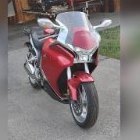-
Posts
2,061 -
Joined
-
Last visited
Reputation
2 NeutralAbout Mekanix
- Birthday 04/05/1969
Previous Fields
-
Other Bikes
1999 Honda Blackbird - RIP June 16, 2010, 2011 BMW K1300S
Contact Methods
-
Website URL
http://
-
ICQ
0
Profile Information
-
Gender
Male
-
Location
Rio Rancho, NM
-
Interests
Overtaking the governments of small third world countries with nothing more than a paper clip and a plastic fork.
-
I honestly don't know how the adjusters could have moved if the bolts were tightened down. They are a physical barrier that, by their nature, would not allow the adjusters to move forward. Now I am confused... If I remember correctly I would torque them suckers down to about 25-30 lbs after locking down the nut. The bolts would have to sink into the swingarm for the adjusters to move forward. PS. I would also search ebay or bikebandit.com and get a new axle shaft if it was stripped. Too much power to be dealing with marginal parts. http://www.bikebandit.com/houseofmotorcycl...151392#sch97126 shows a new axle for $65. also http://www.bikebandit.com/houseofmotorcycl...51392#sch101123 shows the swingarm exploded view. You can see if the adjuster bolt is torqued down the adjuster can't possibly move forward. Once the axle is torqued down, tighten those bolts good and tight (~30lb-ft). Should have no other issues. Good luck!
-
I don't know if this will help or not but, whenever I made chain adjustments, I snugged down the adjusters after I locked down the axle. I read somewhere that it was cheap insurance to make sure the wheel could not move forward. Given the power the XX makes, I figured it made sense. I never had the adjustment change on me.
-
On my truck, if you replace the rack and pinion there is a need to cycle the steering (if I remember, full movement left and right off the ground at a certain rpm like 2000). If this is not done, air is trapped in the system and it will eventually gas out and leave you with a low power steering fluid level. If your rack was recently replaced and it needed to get the bubbles out, you may just need to refill and carry on.
-
I would humbly suggest marksdailyapple.com as a guide for your future path. Essentially, it's Atkins with a twist. Grains bad, meat, fat and plants good. Most dieticians unknowingly prescribe the same diet but then throw in "whole grains are good for you so you need a bunch of that shit". Your mileage my vary. I hate to say it but in every time I lost weight and kept it off, I was always hungry. That seems to be the theme with me. I have come to use it as my indicator that I am doing the right thing instead of the wrong thing. I know for a fact that simply counting calories using any of the internet and phone based calorie counters is the most simple and effective way to monitor calorie intake. It's not what you burn, it's what you take in. You will be amazed what simply tracking your intake will do for you. Best of luck.
-
+1 It might be neater and easier if you have trouble getting under a vehicle or working on the floor, but letting it have a good drain time from the bottom of the oil pan is always better. Shops resort to pumps because it allows them to get a vehicle in and out faster so they can do more customers, but they sacrifice quality in the process...and avoid incidents where they forget to put the drain plug back in. Just to clear things up, I mentioned in the original post that I am working on a sump tank (a dry sump). It's for my BMW KS. Since it is a dry sump, there is almost none of the total engine oil inside the engine. Even by draining, there is still roughly a cup of oil that doesn't drain out because the bottom of the sight tube is below where it would drain, leaving a little oil in the tank if you use the drain method. By using a vacuum drain, it literally sucks the bottom of the sump like a straw sucking the last bit of a milkshake out of the bottom of a cup. In reading about users using the drain method, they claimed 3.75 quarts to refill. Using the suction system, I had to use a full 4 quarts to refill. By that bit of knowledge alone, I am assured that the suction method, at least for my situation, is more complete. The process of changing oil involves draining the dry sump tank, pulling the plug from the bottom of the crankcase and changing the filter. Everything is easy to reach and no panels have to be taken off. It really is a well designed system. I do let the oil, what little there is, drain from the engine plug like normal. One final, final point. There is no drain plug at the bottom of the dry sump.
-
KaziXX - That looks a LOT like the one I saw but it has a chuck and a trigger to let compressed air draw it out. blackhawkxx - Well, since it was the dry sump and there is no plug in the bottom, I guess we got all we could out. If one doesn't use a vacuum pump, the standard instructions are to fish the sight tube down the frame with a plug over the hole, pull the plug and let it dangle under the bike for an hour, then fish it back up and reconnect it. There is also a plug in the block that drains about 1/2 a quart there. I've also looked at the mighty vac, but heard a lot of people complain about the tube collapsing. I think this is what I am going to settle on. http://www.zorotools.com/g/00044176/k-G131...CFWIaQgodsWcA2g It looks like what I had in mind, unless anyone else has any suggestions? Gonna order it tomorrow.
-
So, I had the oil changed by a local garage and they used a cool vacuum pump that ran off compressed air to drain the sump tank. Since I do all that stuff at home anyway, I was wondering if someone else has purchased that particular type of equipment and what they thought of the particular brand they used. Suggestions? Thanks!
-

Ignition key is difficult to put in and take out.................
Mekanix replied to inline4's topic in The Garage
FWIW, WD-40 is a water displacement, not an oil or a solvent or anything else. That it has some properties like them, doesn't make it a lubricant. Use graphite or a light oil of some type. Anything that floats your boat. Hell, I use break free from my gun kit on almost everything that I don't want a lot of residue or dirt attraction on. -

FS: '09 MV Agusta Brutale 1078 $11500
Mekanix replied to davesXX01's topic in The Sales Floor -- For Sale/Wanted
That thing gives me serious wood. If I had that kind of scratch, I would be on it! Not that kind of cash on hand at the moment though and I am looking at buying a new house. Fucking house... -
Mine was a 99. From my experience, 99-00 share similar problems with wiring harness dummy plugs crapping out. I spent a lot of time chasing foggy grounds and having my FI light wink at me from time to time. I did spend a lot of time riding in a lot of rain, so that probably contributed to it. Other than that, no issues other than a R/R at ~45K.
-
Good man on the drinks. I still patch my own but it would kill me today to work like I used to.
-
I, personally, wouldn't trust a plug with my life. IMHO, a bike has only two tires on it. I would plug it and get a new tire as soon as I could. I have done it before. Just plug it. HD aren't known for performance. Get a new tire asap, because I like to stay alive and not in a hospital. Sorry to hear your tire has damage.
-
54K miles before I killed mine. Bike was "running great!" If it ain't broke, don't fix it. Continue to drive until smile fades from face, then take it in to make smile return. (I killed mine by crashing.. it was fine until parts were scattered across a mountainside."
-
A hint. If you are joining two parts in what is essentially a butt joint... get some window screen to act as a binding agent and then JB weld to your heart's content. The mesh acts much like the mesh under concrete. If you don't know that that is, just trust me. It acts as a reinforcement to keep everything together. It might not be perfect, but it will last for a while. (dumbing down... cut some door screen to about 2" bigger than the fix and then jb weld the mesh into the back of the joint. This will help flexibility and breakdown and will keep your bike looking good for a while. Apply the screen reinforcement over the joint with generous coverage. JB weld to join the mesh to the crack.)
-
I've never noticed problems with old tires in a straight line, but twisties can be harrowing. Maybe balance as well. I have noticed air pressure had a big difference on new tires, but I can't verify old tires. Wish I was more help.


